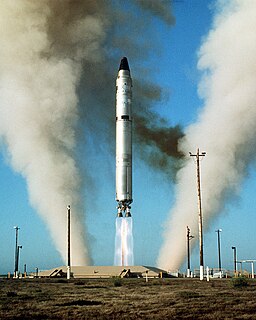
An intercontinental ballistic missile (ICBM) is a missile with a minimum range of 5,500 kilometres (3,400 mi) primarily designed for nuclear weapons delivery. Similarly, conventional, chemical, and biological weapons can also be delivered with varying effectiveness, but have never been deployed on ICBMs. Most modern designs support multiple independently targetable reentry vehicles (MIRVs), allowing a single missile to carry several warheads, each of which can strike a different target. Russia, United States, China, France, India, United Kingdom, and North Korea are the only countries that have operational ICBMs.

The LGM-30 Minuteman is a U.S. land-based intercontinental ballistic missile (ICBM), in service with the Air Force Global Strike Command. As of 2021, the LGM-30G Minuteman III version is the only land-based ICBM in service in the United States and represents the land leg of the U.S. nuclear triad, along with the Trident submarine-launched ballistic missile (SLBM) and nuclear weapons carried by long-range strategic bombers.
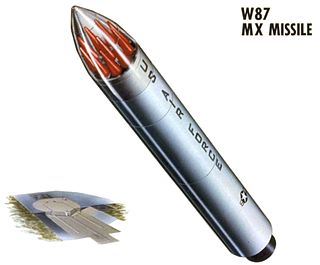
A multiple independently targetable reentry vehicle (MIRV) is an exoatmospheric ballistic missile payload containing several warheads, each capable of being aimed to hit a different target. The concept is almost invariably associated with intercontinental ballistic missiles carrying thermonuclear warheads, even if not strictly being limited to them. By contrast, a unitary warhead is a single warhead on a single missile. An intermediate case is the multiple reentry vehicle (MRV) missile which carries several warheads which are dispersed but not individually aimed. Only China, Russia, United Kingdom, United States and France are currently confirmed to possess functional MIRV missile systems. Israel is suspected to possess or be in the process of developing MIRVs.
The SM-65 Atlas was the first operational intercontinental ballistic missile (ICBM) developed by the United States and the first member of the Atlas rocket family. It was built for the U.S. Air Force by the Convair Division of General Dynamics at an assembly plant located in Kearny Mesa, San Diego. Atlas became operational in October 1959, but was soon made obsolete as an ICBM by new development, and was retired from this role by 1965.
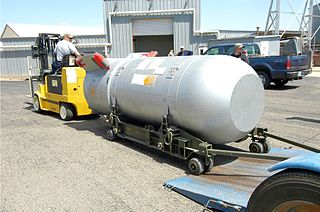
The Mk/B53 was a high-yield bunker buster thermonuclear weapon developed by the United States during the Cold War. Deployed on Strategic Air Command bombers, the B53, with a yield of 9 megatons, was the most powerful weapon in the U.S. nuclear arsenal after the last B41 nuclear bombs were retired in 1976.
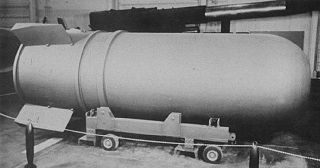
The B-41 was a thermonuclear weapon deployed by the United States Strategic Air Command in the early 1960s. It was the most powerful nuclear bomb ever developed by the United States, with a maximum yield of 25 megatons of TNT. The B-41 was the only three-stage thermonuclear weapon fielded by the U.S.

The explosive yield of a nuclear weapon is the amount of energy released when that particular nuclear weapon is detonated, usually expressed as a TNT equivalent (the standardized equivalent mass of trinitrotoluene which, if detonated, would produce the same energy discharge), either in kilotons (kt—thousands of tons of TNT), in megatons (Mt—millions of tons of TNT), or sometimes in terajoules (TJ). An explosive yield of one terajoule is equal to 0.239 kilotonnes of TNT. Because the accuracy of any measurement of the energy released by TNT has always been problematic, the conventional definition is that one kiloton of TNT is held simply to be equivalent to 1012 calories.

Nuclear weapons delivery is the technology and systems used to place a nuclear weapon at the position of detonation, on or near its target. Several methods have been developed to carry out this task.

The W-71 nuclear warhead was a US thermonuclear warhead developed at Lawrence Livermore National Laboratory in California and deployed on the LIM-49A Spartan missile, a component of the Safeguard Program, an anti-ballistic missile (ABM) defense system briefly deployed by the US in the 1970s.
The W66 thermonuclear warhead was used on the Sprint anti-ballistic missile system, designed to be a short-range interceptor to shoot down incoming ICBM warheads.

The W78 thermonuclear warhead is the warhead used on most of the United States LGM-30G Minuteman III intercontinental ballistic missiles (ICBMs), along with the MK-12A reentry vehicle which carried the warhead. Minuteman IIIs initially deployed with the older W62 warhead; the W78 was deployed starting in December 1979 onto 300 missiles, three warheads per missile. Declassified records indicate a total of 1,083 W78s were produced.

The W87 is an American thermonuclear missile warhead formerly deployed on the LGM-118A Peacekeeper ("MX") ICBM. 50 MX missiles were built, each carrying up to 10 W87 warheads in multiple independently targetable reentry vehicles, and were deployed from 1986 to 2005. Starting in 2007, 250 of the W87 warheads from retired Peacekeeper missiles were retrofitted onto much older Minuteman III missiles, with one warhead per missile.
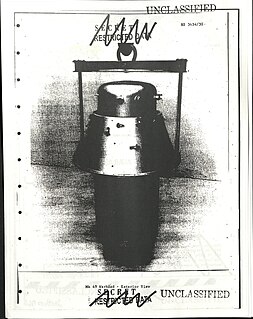
The W49 was an American thermonuclear warhead, used on the Thor, Atlas, Jupiter, and Titan I ballistic missile systems. W49 warheads were manufactured starting in 1958 and were in service until 1965, with a few warheads being retained until 1975.

The W47 was an American thermonuclear warhead used on the Polaris A-1 sub-launched ballistic missile system. Various models were in service from 1960 through the end of 1974. The warhead was developed by the Lawrence Radiation Laboratory between 1957 and 1960.

The W62 is an American thermonuclear warhead designed in the late 1960s and manufactured from 1970 to 1976, used on some Minuteman III ICBMs and retired in 2010.
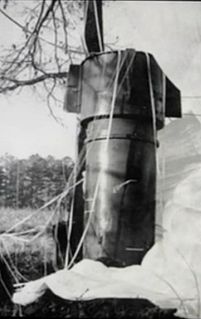
The Mark 39 nuclear bomb and W39 nuclear warhead were versions of an American thermonuclear weapon, which were in service from 1957 to 1966.
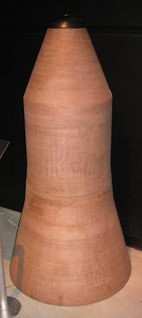
The W59 was an American thermonuclear warhead used on some Minuteman I ICBM missiles from 1962 to 1969, and planned to be used on the cancelled GAM-87 Skybolt air-launched ballistic missile. Modified to use a less-sensitive high explosive in the primary, the design formed the basis for the British WE.177, used by both the Royal Air Force and Royal Navy.
The Mark 27 nuclear bomb and closely related W27 warhead were two American thermonuclear bomb designs from the late 1950s.














